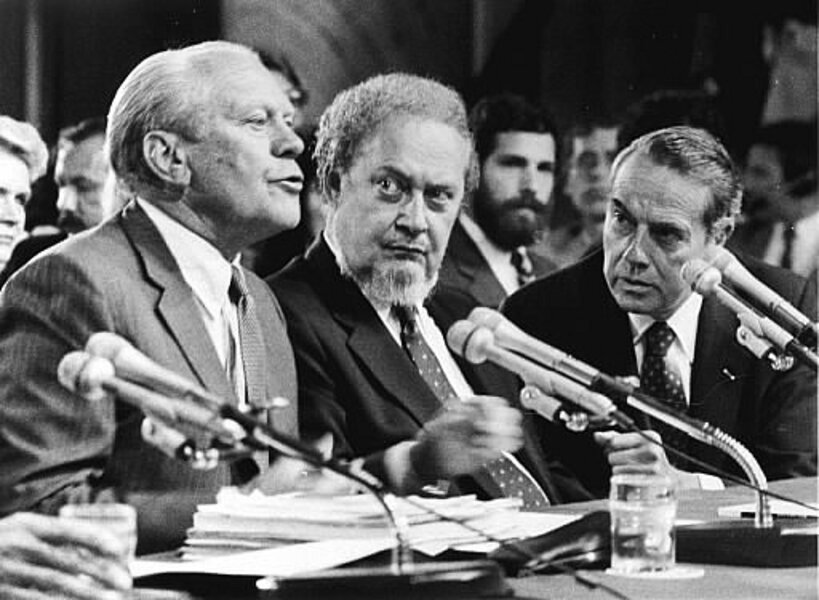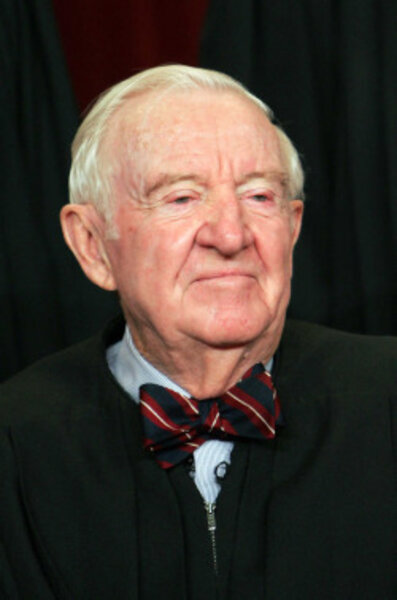Justice Stevens retirement portends long, hot political summer
Loading...
| Washington
The confirmation battle over the replacement for Supreme Court Justice John Paul Stevens, who announced his retirement Friday, could become one of the most heated US political struggles of the summer.
In part, that’s because of the particulars of President Obama’s situation. His poll numbers have dipped, and Republicans are looking to capitalize on perceived Democratic vulnerability in advance of next fall’s mid-term elections.
But it’s also due to the general fact that over the last 30 years or so Supreme Court nominations have developed into an intense form of US political theater. Parties and interest groups use them to tussle over everything from hot button issues such as abortion to the general ideology that divides them – as well as the qualifications of the nominee.
IN PICTURES: Frequently mentioned Supreme Court possibilities
“There’s been a kind of escalation in the process,” says Lawrence Baum, a political science professor at Ohio State University who’s an expert on judicial politics.
Justice Stevens said that he would step down when the court finishes its work on this session to allow enough time for his replacement to be confirmed before the next term begins in October.
President Obama said Friday that he would quickly move to name a successor who would be similar to Stevens.
This will be “someone who, like Justice Stevens, knows that in a democracy powerful interests must not be allowed to drown out the voices of ordinary citizens,” Obama said.
Leading candidates are said to include Solicitor General Elena Kagan, and federal appeals court judges Merrick Garland and Diane Wood.
The modern drama of the confirmation hearing – with the nominee sitting at a table before the Senate Judiciary Committee for questioning – is a recent phenomenon, historically-speaking. It didn’t become routine until the late 1950s, after Eisenhower nominee John Marshall Harlan became the first sitting judge to personally appear before the Senate panel.
The process became somewhat more contentious through the following several decades. But in general, opponents targeted only personal failings or shortcomings of nominees, not judicial philosophy.
“If you found a skeleton in their closet, you could go after them,” says Leonard Gross, a law professor at Southern Illinois University.
Thus in 1970, Nixon nominee G. Harrold Carswell was rejected after widespread criticism by Democrats and some Republicans that his legal acumen was mediocre.
That all changed in 1987. Federal appeals court judge Robert Bork, nominated by President Reagan to replace the moderate Supreme Court Justice Lewis Powell, quickly ran into trouble with Democrats and liberal interest groups due to his conservative views.
Few of Bork’s opponents questioned his professional qualifications. Instead, they focused on his judicial philosophy, which holds that many liberal judges have gone too far in rulings, in essence legislating from the bench.
Bork was defeated in the Senate by a vote of 58 to 42.
Since then “it’s fair to say there has been much more focus on judicial ideology,” says Gross, co-author of a book on Bork and the politicization of Senate confirmations.
Subsequent nominees generally have learned from Bork’s mistakes, and been less willing to be forthcoming with blunt answers to questions about their ideological beliefs.
But since Bork both parties have learned that there is possible advantage in trying to portray nominees as people who are out of the nation’s political mainstream. Interest groups have discovered that there is lots of money to be raised and attention to be gained by leading the fight against nominees with whom they disagree.
Meanwhile, Washington itself has become more and more partisan.
What’s that led to? A situation in which almost every Supreme Court nomination will be deemed “controversial” by a president’s political opponents.
There was substantial opposition in the Senate to the nominations of both Chief Justice John G. Roberts and Justice Sonia Sotomayor, points out Lawrence Baum of Ohio State University. Yet both had unassailable professional credentials.
“Neither Roberts nor Sotomayor would have been controversial in an earlier time,” says Baum.
IN PICTURES: Frequently mentioned Supreme Court possibilities






